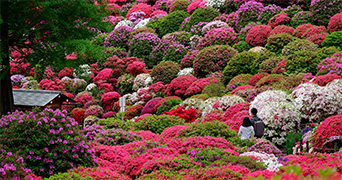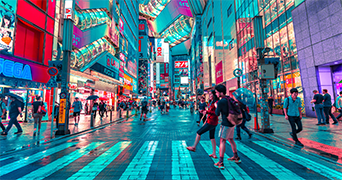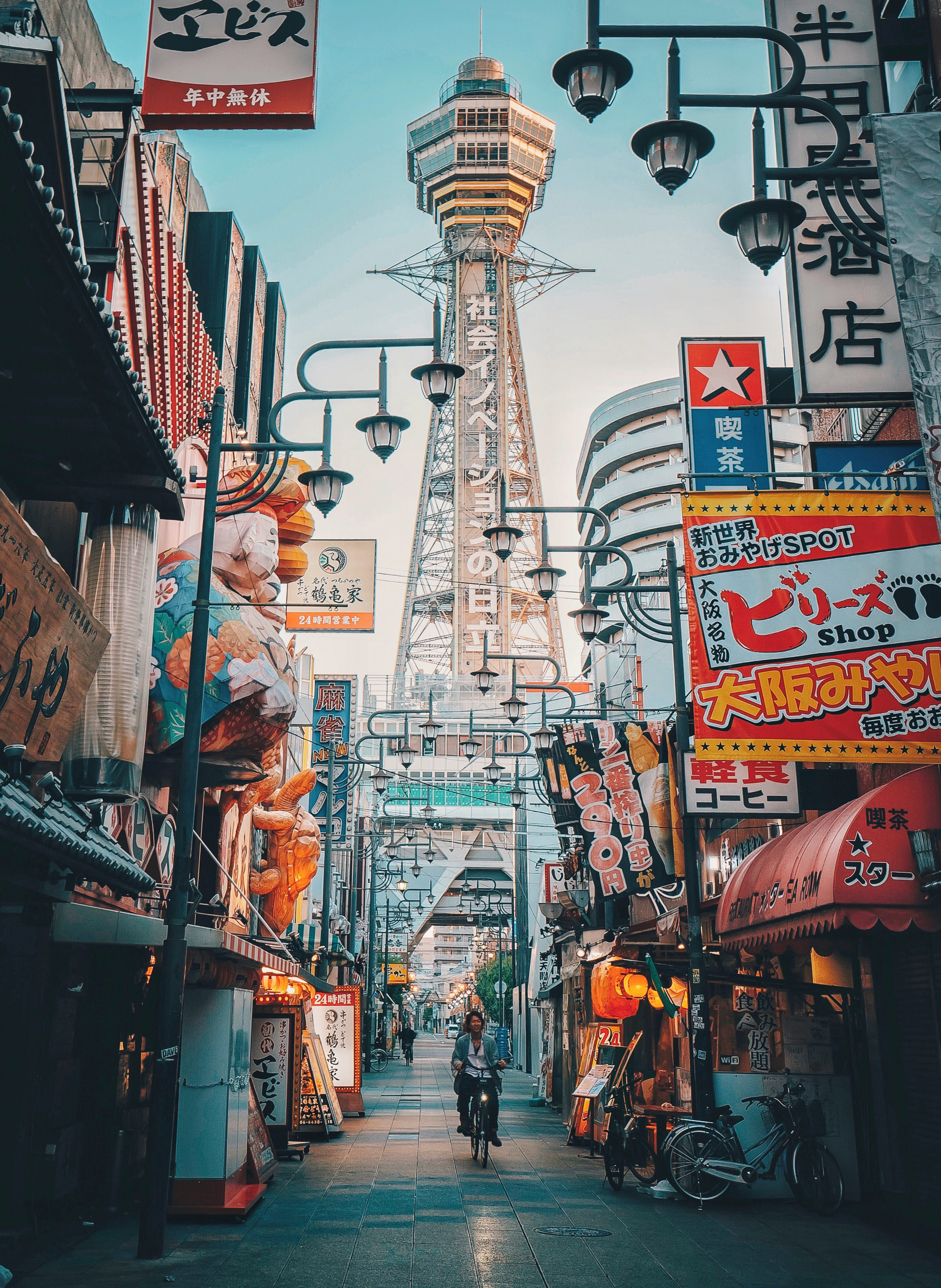
























Tokyo, historically known in the West as Tokio and officially the Tokyo Metropolis, is the capital, the largest city, and the most populous metropolitan area in the Greater Tokyo Area, the Kantō region, and Japan, as well as the most populous metropolitan area in the world and most populous prefecture of Japan. Located at the head of Tokyo Bay, the prefecture forms part of the Kantō region on the central Pacific coast of Japan's main island of Honshu. Tokyo is the political and economic center of the country, as well as the seat of the Emperor of Japan and the national government. As of 2021, the prefecture has an estimated population of 14.04 million. The Greater Tokyo Area is the most populous metropolitan area in the world, with an estimated 37.468 million residents in 2018.
Tokyo is an international center of research and development and is represented by several major universities, notably the University of Tokyo. Tokyo Station is the central hub for Japan's Shinkansen bullet train system, and the city is served by an extensive network of rail and subways. Shinjuku Station is also the world's busiest train station. Notable districts of Tokyo include Chiyoda (the site of the Imperial Palace), Shinjuku (the city's administrative center), and Shibuya (a commercial, cultural and business hub).

Kyoto, officially Kyoto City, is the capital city of Kyoto Prefecture in Japan. Located in the Kansai region on the island of Honshu, Kyoto forms a part of the Keihanshin metropolitan area along with Osaka and Kobe. As of 2021, the city has a population of 1.45 million, making up 57% of the prefecture's total population. The city is the cultural anchor of a substantially larger metropolitan area known as Greater Kyoto, a metropolitan statistical area (MSA) home to a census-estimated 3.8 million people in 2020 and ranking as the second MSA in the Kansai region.
Kyoto is well known for its traditional festivals which have been held for over 1,000 years and are a major tourist attraction. The first is the Aoi Matsuri on May 15. Two months later (July) is the Gion Matsuri known as one of the 3 great festivals of Japan, culminating in a massive parade on July 17. Kyoto marks the Bon Festival with the Gozan no Okuribi, lighting fires on mountains to guide the spirits home (August 16). The October 22 Jidai Matsuri, Festival of the Ages, celebrates Kyoto's illustrious past.

Osaka is a designated city in the Kansai region of Honshu in Japan. It is the capital and the most populous city in Osaka Prefecture, and the third most populous city in Japan, following Tokyo and Yokohama (both located in the Greater Tokyo Area and the Kantō region). With a population of 2.7 million in the 2020 census, it is also the largest component of the Keihanshin Metropolitan Area, the second-largest metropolitan area in Japan and the 10th largest urban area in the world with more than 19 million inhabitants.
Osaka is a major financial center of Japan, and it is recognized as one of the most multicultural and cosmopolitan cities in Japan. The city is home to the Osaka Securities Exchange as well as the headquarters of multinational electronics corporation such as Panasonic and Sharp. Osaka is an international center of research and development and is represented by several major universities, notably the Osaka University, Osaka Metropolitan University and Kansai University. Famous landmarks in the city include Osaka Castle, Osaka Aquarium Kaiyukan, Dōtonbori, Tsūtenkaku in Shinsekai, Tennōji Park, Abeno Harukas, Sumiyoshi Taisha Grand Shrine, and Shitennō-ji, one of the oldest Buddhist temples in Japan.

Hiroshima is the capital of Hiroshima Prefecture in Japan. As of June 1, 2019, the city had an estimated population of 1,199,391. The gross domestic product (GDP) in Greater Hiroshima, Hiroshima Urban Employment Area, was US$61.3 billion as of 2010. Kazumi Matsui has been the city's mayor since April 2011. Hiroshima Prefecture is located in the southwestern part of the Japanese islands. It is rich in the natural beauty of the Inland Sea and the Chugoku Mountains, with mountains, sea, rivers, valleys, plains, basins that characterize Japan's landscape.
Hiroshima prefecture can be roughly divided to the four areas - Aki in the southwest, Bingo in the southeast, Geihoku in the northwest, and Bihoku in the northeast. Each area has its own distinct local cultures, food and customs, making Hiroshima Prefecture a varied and exciting destination for visitors. Its geological features include mountains, sea, islands, rivers, valleys, plains, and highlands, essentially all of the natural elements found throughout Japan. Mountains make up approximately 73% of the land in the prefecture, and Hiroshima’s 138 islands dot the Inland Sea. Hiroshima is blessed by a generally warm climate and is relatively unscathed by natural disasters such as typhoons and earthquakes. Nevertheless, the difference in climate between the mountainous north and the southern coast is quite pronounced. In the north, the average temperature is 12C and rainfall is 1,700mm, compared to 15C and 1,500mm in the south.

Sapporo is a city in Japan. It is the largest city north of Tokyo, Japan and the largest city on Hokkaido, the northernmost main island of the country. It is the capital city of Hokkaido Prefecture and Ishikari Subprefecture. Sapporo lies in the southwest of Hokkaido, within the alluvial fan of the Toyohira River, which is a tributary stream of the Ishikari. It is considered the cultural, economic, and political center of Hokkaido.
The annual Sapporo Snow Festival draws more than 2 million tourists from abroad. Other notable sites include the Sapporo Beer Museum, which is the only beer museum in Japan, and the Sapporo TV Tower located in Odori Park. It is home to Hokkaido University, just north of Sapporo Station. The city is served by Okadama Airport and New Chitose Airport in nearby Chitose. Sapporo not only provides great sightseeing, dining and shopping spots but also full-scale ski resorts that are only a few steps away. With many areas receiving heavy snow. Sapporo is currently bidding for the 2030 Winter Olympics. The Sapporo Dome hosted three games during the 2002 FIFA World Cup and two games during the 2019 Rugby World Cup. Additionally, Sapporo has hosted the Asian Winter Games three times, in 1986, 1990, and 2017.

Hakone is a town in Kanagawa Prefecture, Japan. As of 1 April 2021, the town had an estimated population of 10,837 and a population density of 3000 persons per km². The total area of the town is 92.82 km2. The town is a popular tourist destination due to its many hot springs and views of Mount Fuji.Hakone has a Humid subtropical climate characterized by warm summers and cool winters with light to no snowfall. The average annual temperature in Hakone is 13.3 °C. The average annual rainfall is 2221 mm with September as the wettest month. The temperatures are highest on average in August, at around 24.0 °C, and lowest in January, at around 2.9 °C. Hakone is part of the Fuji-Hakone-Izu National Park, less than one hundred kilometers from Tokyo.It is famous for hot springs, natural beauty and the view across Lake Ashinoko of nearby Mount Fuji, Hakone is one of the most popular destinations among Japanese and international tourists looking for a break from Tokyo. It also encompasses Hakone Shrine, a Shinto shrine with a red “torii” gate overlooking Lake Ashi, which can be toured by boat, as well as the boiling sulphur springs of the Owakudani Valley.